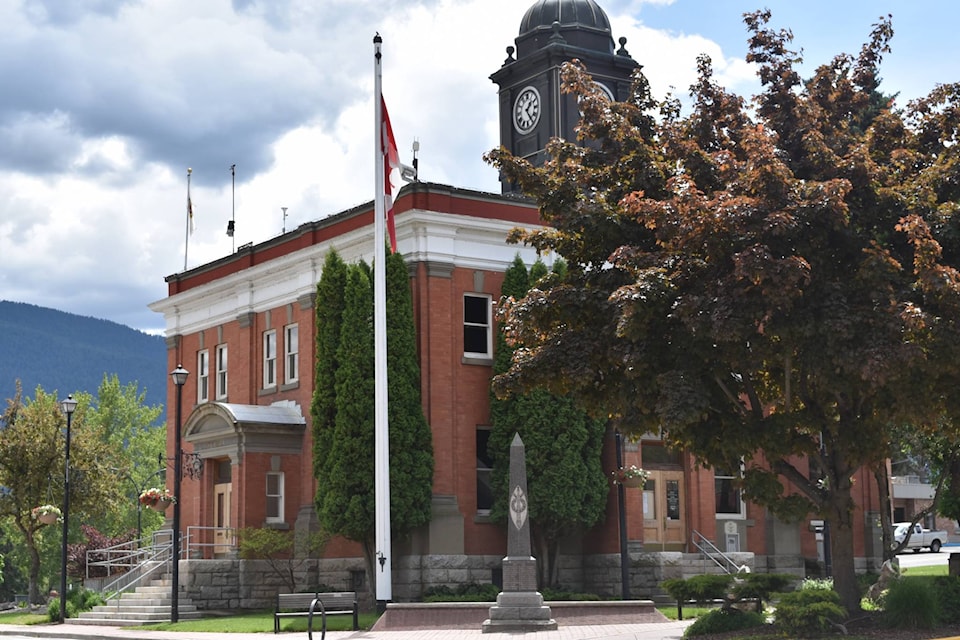The sun was shining on the City of Grand Forks council on Monday after councillors decide to move forward with a solar energy project for City Park this year.
The Solar Now project was brought back to the table at Monday night’s regular meeting of council after being defeated two weeks ago at the council table. In her report to council, Coun. Colleen Ross asked for the project to be brought back for reconsideration, and it was added as a late item to Monday’s agenda by Mayor Frank Konrad.
The project has a budget of $65,000, $40,000 of which will be supplied by the city, with $25,000 to come from grant funding. The project will install solar panels, tentatively proposed for the stage between the mechanical room and the washroom on the stage at the east end of City Park. The solar panels would create a kind of shade shelter.
The city’s portion of the funding will come from the city’s Climate Action Revenue Incentive Program (CARIP) reserve fund. This is a mandatory fund the city pays into every year, and the funds must be used specifically for a project that demonstrates the city’s commitment to offsetting its carbon footprint.
Ross said she felt the appeal of the project was threefold: the environmental, educational and leadership benefits are important, she said.
“It demonstrates our willingness and interest in exploring new and upcoming technologies, not that it is [a new technology], but it is constantly improved and renewed,” she said. ”It is a point of interest for students to gather and learn, it shows leadership and it puts us on the map in a good way.”
Ross also mentioned the District of Summerland, which recently secured $6-million in federal gas tax funding for a solar project.
Konrad, who was the deciding vote in defeating the project the last time it appeared before council, said he would be supporting the project going forward.
“I also voted against this and that’s why I brought it back. At that time it was my view that the return on the project … but that was a short-term vision on my part, looking for longer-term seeing the possibilities that could occur…” Konrad said. “As elected officials, we should be looking for the future of what we are able to give to our constituents and our community. I think it is a viable project for the community, especially being one of five that have their own electrical utility.”
Coun. Ben Tripp inquired about a new and upcoming technology for solar panels, wondering whether the city could wait on the project until graphene panels are commercially available.
However, Deputy Manager of Operations Cavan Gates said that the project must be completed in 2018, and further that in future, switching solar panels will be cost effective.
“The panels are the least expensive part of solar installation now … about a fifth to a quarter of the project budget,” Gates said. “When and if [graphene panels] come to mass market, swapping out the panels is not redoing the project, it is repurposing or potentially enhancing. It would be feasible to swap them out since the infrastructure is already in place.”
Coun. Julia Butler said the project was just for “show” and suggested waiting for graphene panel technology.
“I don’t want to put something up for show if it is not doing us any good. What example are we setting that we are spending money on something that is not actually producing for us?” Butler said, suggesting the city wait a couple of years before embarking on a project.
“I would save, get the best bang for my buck, and when it becomes financially viable, invest,” she later added.
The proposed location for the panels is between the mechanical room and the washroom on the stage in City Park, creating a type of shade shelter. However, Gates said that no location is confirmed, pending a technical review for solar potential, which will be done in the coming months.
In response to questions from the Gazette, Gates said the “back of the napkin” calculation for the return on the solar panels is 30 years, but that number is a loose estimate and could be high as it will depend on the outcome of the solar review and location and angle of the panels. A more detailed figure will be established following the solar review and the establishment of the project schedule, he said.
Gates also clarified that the money for the project is already in place in the CARIP reserve, a dedicated account the city contributes towards every year. A bylaw governs how that money must be spent, and this project qualifies under that bylaw, he said.
However, Butler likened the money to “play money.”
“It is just play money, not good for anything so might as well spend it,” Butler said.
Ross said she felt that regardless of improving and changing technologies, it is important to move forward with this project sooner rather than later.
“The solar panels we use today are more efficient than the ones they used even six months ago,” she said. “This is not a new technology, we are a little slow off the mark here. We are not wasting money, we are investing in the future.”
The project passed, with Butler opposed.
